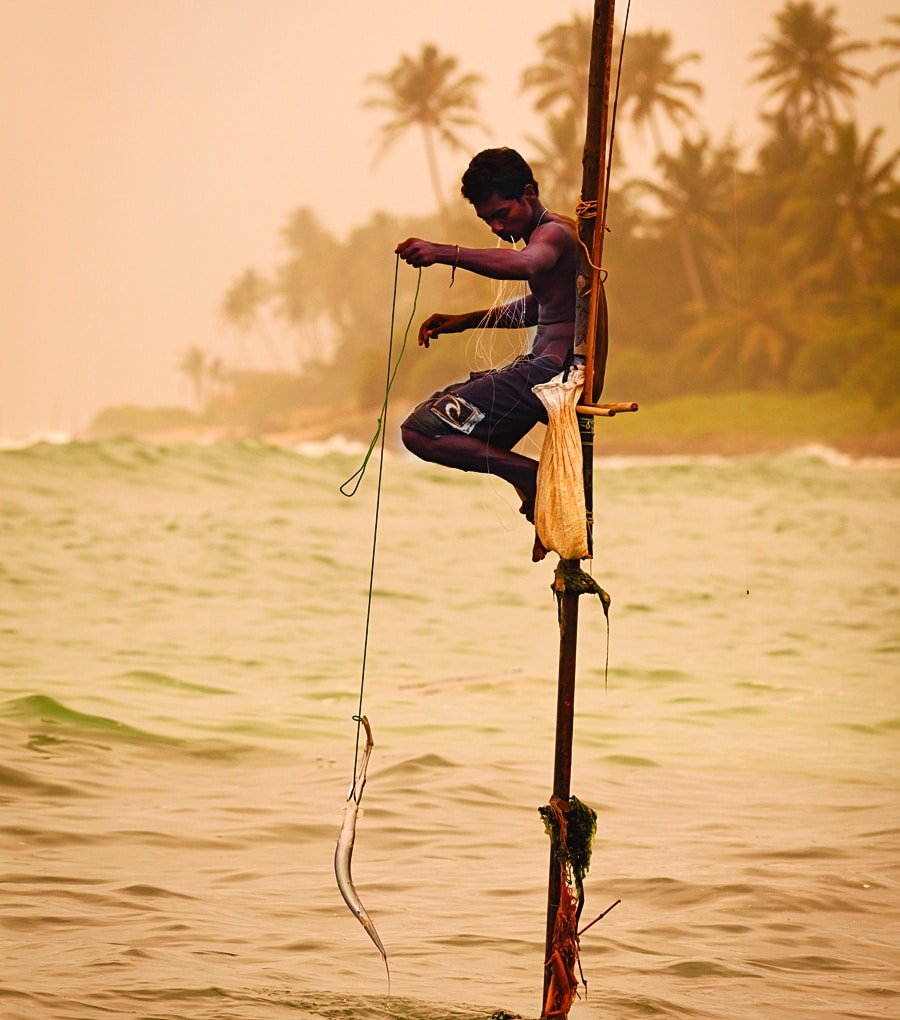The Last Untouristed Country
They want me to take their pictures. These surly seamen balanced atop precarious poles. They're tilting over the water, trying to catch two-cent minnows. They wave me over with roguish grins and implore me to document their existence. It's an offer I cannot refuse. The stilt fishermen of Sri Lanka are an iconic sight the way moon craters are an iconic sight: seen in a few photos but rarely in person. And to think the stilt fishermen who hover before me almost disappeared forever.
The Boxing Day tsunami of 2004 swallowed more than 30,000 people here in one disastrous moment. The fishermen abandoned their posts. Nobody felt much like hovering over the sea anymore. The wave came during a civil war, amid a stew of indigenous unrest. Sri Lanka had seen its share of strife.
But Sri Lankans are resilient. Incredibly, the tide is already turning. I know it's turning because they invited me here. Not to dig them out but to witness a true endangered species: the last untouristed country. I arrive like a big-game hunter. Camera in hand. Notebook poised. I'll mount my kill in a magazine and tell my grandchildren: "I was there before the tour buses."
An hour off the plane, I'm petting elephants in the wild. No game park. No zoo. I just ask my cab driver to pull over, walk a few paces into the bush and stand face to face with this hulking wonder. She could crush me with her eyelids. But instead, she extends her wrinkled trunk to touch my outstretched hand.
"Did you see that?" I ask my driver, wishing he'd snapped a picture. The driver returns a happy little head-wobble.
"You should not do this,"he says.
"Really? Why not?"
"Very, very dangerous," he wobbles. "You could die."
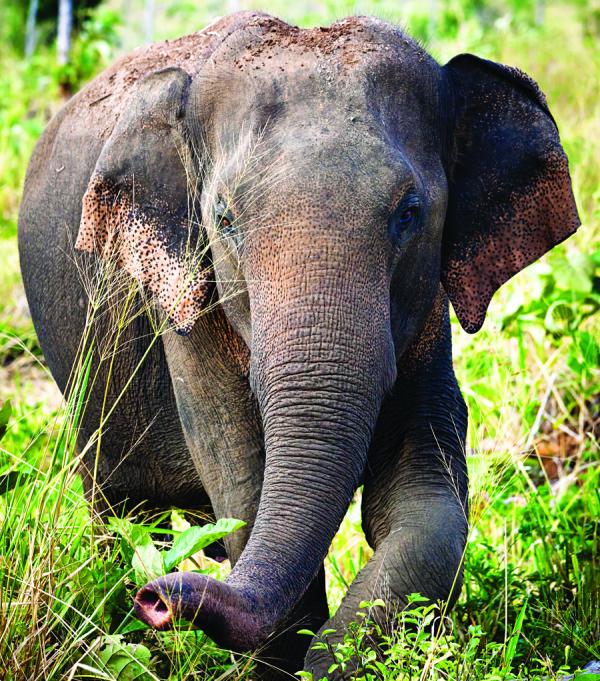
Photo by: R. Ian Lloyd
You see? This is what they've been telling us all these years about Sri Lanka. Danger. Keep out. But the war was isolated to the far north. The tsunami affected a stretch of coastline. And that elephant was actually very friendly. So here I go. No plan. No guidebook. No map. I rush right into the jungle and pet the first elephant I see before they can build a fence around it. Before they can write "Do Not Touch." And OK, maybe I'll get trampled to death. But maybe next time my driver will remember to snap a picture.
I wake up in the 17th century. Antique bed. Clawfoot bathtub. My room at the Amangalla Hotel in Galle may be only 100 years old, but the Dutch colonial fort just outside dates back much further. One step out the door and I'm part of a living museum. Uncaptioned and inescapable. Women in bright saris with brighter umbrellas stroll narrow cobblestone alleys. Old men creak their rocking chairs outside crumbling mansions. Historic storefronts are open for business.
A rusted three-wheeler pulls up and the driver offers a learned grin. "Come," he says. "I show you everything."
The freelance tour guide is one of the classic beauties of the untraveled country. For a negotiable pittance, your tour comes refreshingly unorganized. And of course, "Where are you from? Ah, Obama. Homer Simpson. American Idol. You like see temple? Maybe buy gemstones?" Sure. Why not? And doh!
In a whir of wind-in-my-hair three-wheeling, my guide delivers a 200-year-old tea plantation still producing Sri Lanka's fabled "virgin white tea" (from seed to sip never touch- ing human hands). Next we visit a 40-yard-long, 12th-century Buddha, where young monks interrupt solemn meditation to chase monkeys from the shrine. Then come the olfactory assaults of a spice market and roadside fish still moist from the sea. At each spectacle, I'm the only tourist in sight. My driver tags along, pointing out photo ops and fabricating factoids.
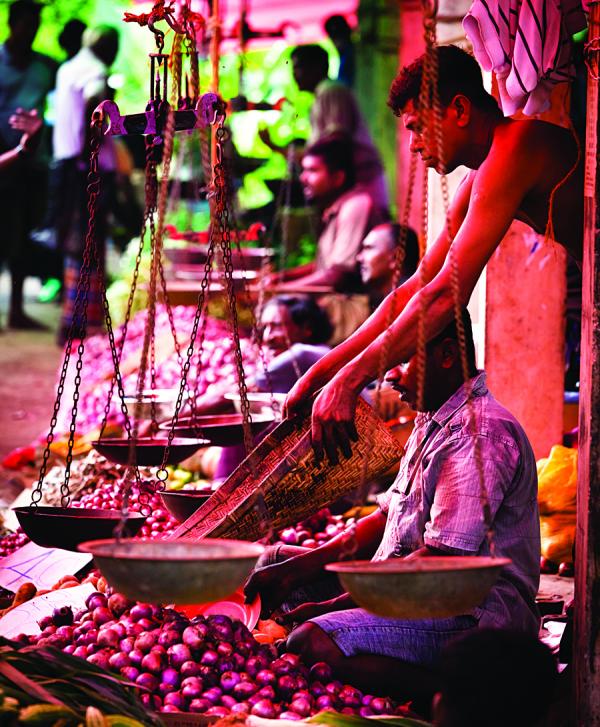
Photo by: R. Ian Lloyd
Each bend in the road presents a thrilling bouquet of surprises. But the isolation is getting a bit eerie. I hadn't expected to be so right about being the only tourist. Like at my previous Sri Lankan hotel. It had decadent views and private beaches, and I had to ask a bellhop the obvious. "Am I the only one here?"
"No, no," he said, laughing at my silly question. "The hotel is almost 20 percent occupied right now. Very full."
Empty isn't a problem for a romantic getaway, but it's less than ideal for shooting portraits. So my driver takes me to the "popular" Unawatuna Beach, an international cliche of beach-front cafes and techno traditionals. I shoot pool with some Dutch backpackers exploring the country on motorcycles because they "didn't know anyone else who had done it." We're joined by a Russian girl who's here learning to surf and might buy some land. "I like the warm water," she says. Beyond that, most of the clubs are fairly empty. Waiting, it feels like.
I step out to the beach, staring impatiently at the groggy afternoon night life. This isn't what I was looking for. I head up the beach toward massive trees and houses on stilts. I sit on a boulder overlooking a small river meeting the ocean. Tiny fish have swum upriver and become trapped in an eddy. Crows are feeding on them, but get chased away by chattering monkeys. Wild dogs burst from the jungle to chase the monkeys. Before my eyes, the cycle of life spins its wobbly wheels. I'm trying to photograph this unlikely collision when I notice a young monk seated beside me. Red robes. Shaven head. Eyes like the rising moon. He's staring at me as if I were the only puzzle piece out of place here.
I snap his portrait and he delights at his own image in the display. Again, he beckons. Again. We repeat the shot a dozen times. I'd never believed what they said about photos stealing souls until I met someone who actually had one.
Finally, I turn the camera off and the monk wanders off disappointed. It's almost dark, but I take a moment to inspect my shots of the monk. There's something in his eyes. Something completely out of place. I zoom in closer on his eyes. A distorted reflection glimmers back. Holding a camera.
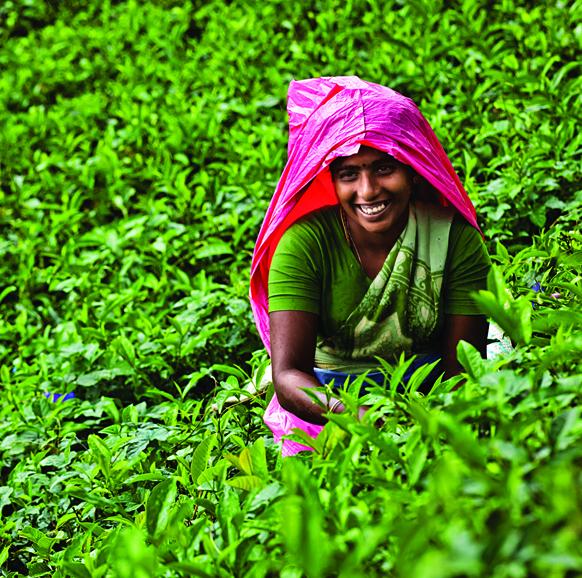
Photo by: R. Ian Lloyd
My driver is waiting to whisk me away. Life is better on three wheels. It's wide open. No doors. Cracked windshield. The road blurs past at arm's reach. Ox-drawn wagons. Rice paddies. Monsoon horizons. I promise I won't think of tsunamis, or even say the word.
"This road is amazing," I tell my driver. "I'm surprised to find such perfect pavement way out here."
"The Americans just built this road," he explains. And then he has to say the word. "After the tsunami, no road at all."
Since my arrival, Salaheem has served as my driver, tour guide, translator, historian, dinner date and personal shopper. He's my best friend here. "You must have lost many roads that day," I say, expressing my worldly compassion.
"Roads?" he says. "I lost my house. My family. Everything." Following a guilty silence, my ride home becomes a post-tsunami tour package. Coming up on our right, you'll see the housing development built by the Germans after the tsunami. And there is a water tower the Dutch donated after the tsunami.
This electrical plant was from the English after the tsunami. It's a punctuation mark: "after the tsunami." Even logging on to the Internet, "after the tsunami, download speed not so good. ..."
Wasn't the tsunami, like, seven years ago? That's back when Myspace was still cool. That's pre-Prius. "Seven years is not so long to a child who loses his parents," Salaheem replies.
Oh, he's good. So much for dodging the tsunami. Maybe it's better to wave right back at it. Certainly it's more interesting. "Where were you during the tsunami?" I ask Fred Netzband-Miller, sitting on the ocean-view veranda of his Siam View Hotel. Fred arrived in Arugam Bay in 1970, parked his motorcycle, met a girl, bought the land and never left.
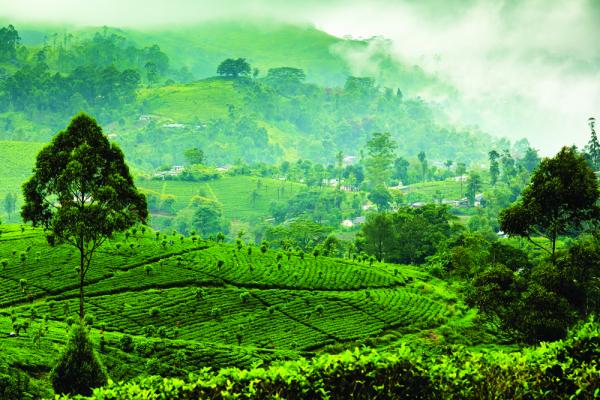
Photo by: R. Ian Lloyd
"When the tsunami hit, I was right here on this deck," he says. From his second-story balcony, we look out over Arugam's famous point break, once part of the world surfing tour. "I'd just invested my life savings into building 24 bungalows," he says.
"We threw a big party the night before to celebrate their opening, and the next morning the waves came in. We sat on this very deck serving gin and tonics thinking it was the end of the world." "I'm surprised you're still here," I say.
"I couldn't afford to leave if I wanted to," he says. "I lost a million dollars in half an hour." Down on the beach, a crowd of Sri Lankans are gathering for a pre-sunset splash. Playing cricket. Building sand castles. Wading the gentle shore break. Fred says this is one of the few areas where Muslims, Tamils and Buddhists mingle. Staring down on the crowd, any distinction is invisible.
The city is an eyesore. Traffic. Smog. Industry. Worst of all is the military presence. Soldiers on every corner. Machine guns and checkpoints. I raise my camera toward a soldier and he aims his Uzi in reply. Point taken: Don't shoot the soldiers. I should have told this story backward. Colombo is the wrong ending for Sri Lanka's golden return of tourism. My meeting with the monk was better. So were the empty beaches and friendly elephants. And the tours on three wheels. Anything but this.
But it's my last day, so I march into the urban wilds alone and terrified. Or maybe just exhausted. Each alley feels vaguely threatening. Constrictive. I can barely breathe here.
The three-wheel drivers approach like hustlers. Children no longer beg to have their pictures taken. Women quicken their pace. Soldiers tense their trigger fingers. The city is busy. An elephant trudges along the sidewalk, shackled in Christmas lights and prodded by two handlers with a tip jar. Exploiting nature's wonder as a sideshow novelty. I snap a photo and drop some change in the jar. Then I head for the sea.
The boardwalk welcomes me. Pony rides and cotton candy. Children with kites and drums. Sunset over the ocean. Soldiers lower a flag, and I shoot a final image in the dying light. The sky is bruised and bloody as I sit on a curb eating street curry and scrolling through my images. There are shots of waterfalls and the stilt fishermen. Plantation workers and the crumbling relics of Fort Galle. If I delete them all, Sri Lanka might cease to exist. My grandchildren could visit and their Colombo is abuzz with its high-profile stupa and markets. But the mood is still humble in Fort Galle, where police women and fig trees are the most welcoming figures. Would still be no tour buses or ticket lines. They'd pet the wild elephants and people would say, "What tsunami?"
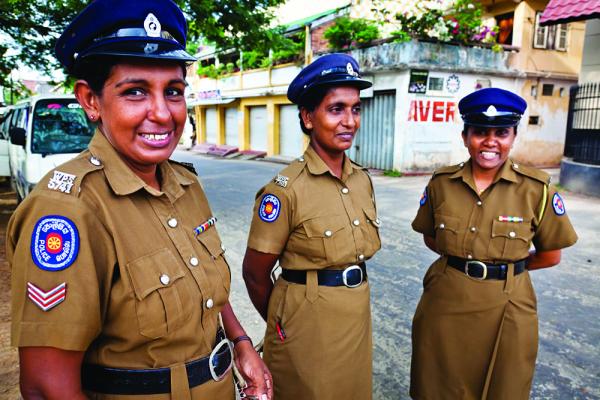
Photo by: R. Ian Lloyd
But real stories don't tell themselves backward. History is a freight train. A young man sits on the curb beside me, eating his dinner of curry, same as mine."You are a photographer?" he asks, glancing over at my camera display.
"No, not really a photographer," I say. "Just a tourist."
"You should come to the north, where I am from," he says, still looking more at the camera than at me. "So very beautiful."
His comment reminds me of how much of the country I've left untoured. "Isn't that where all the fighting was?" I ask. "The war is over," he says. "So much beauty there. Very remote. Things you cannot see anywhere else." "Tell me, why does this city still feel so ... military?" "The war has been more than my whole life," he says. "We are still being very careful. But don't worry. You are safe."
"Are you a tour guide?" I ask. "No. I am a soldier. But maybe, someday. That is my dream."
The ocean is just a sound now. A dark memory. The sky is shot full of holes. Magnificent and mundane. "What else have you seen of Sri Lanka?" the soldier asks, nod- ding at my camera. The display reveals those iconic stilt fisher- men, and I recall how they'd invited me to climb up their poles.
The stilt fishermen have returned to the water. And they want pictures. These surly rogues. They didn't smile when I snapped their photos, but they're all toothy now as they invite me to sit atop their teetering perch. My mouth says, "No, no, I couldn't possibly ..." but already I'm passing off my camera and rolling up my shorts. Photographically speaking, stilt fishing is Sri Lanka's defining image, gracing the cover of Lonely Planet and every other recently distributed travel guide. I can't help thinking to myself, if stilt fishing's purpose is to avoid disturbing the fish, then what could possibly be worse than busloads of tourists tramping out to collect their souvenir photos, whenever that starts happening?
Today, however, there's still no stepladder. No handholds. No "You must be this tall" sign. I shimmy up the pole and squirm, twist and wiggle into a trembling semblance of semiseatedness on the fragile crossbar. And there I am: a tourist on full display. I wave to the beach, where a salty sea dog snaps away with my camera, worth several years of tiny fish. Even from here I can see he's got the lens cap on.
